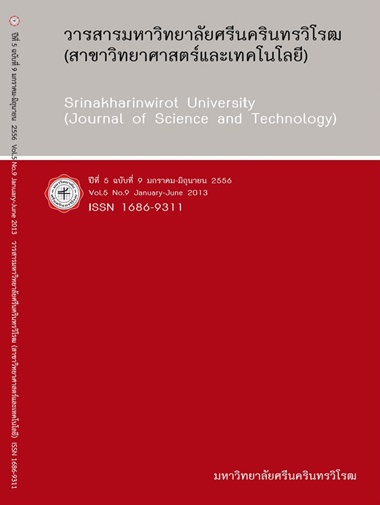การสังเคราะห์และการแยกอิแนนทิโอเมอร์ของสารมัธยันตร์อิปอกไซด์ และออกซาโซลิดิโนนของยาปฏิชีวนะลีเนโซลิดด้วยการใช้ HPLC และ GC โครมาโตกราฟีที่มีไครัลคอลัมน์ชนิดพิเศษ
Keywords:
Intramolecular Cyclisation, Oxazolidinone, Antibiotic Linezolid, Separation of EnantiomersAbstract
บทคัดย่อการพัฒนากรรมวิธีการสังเคราะห์ยาปฏิชีวนะลีเนโซลิด (Linezolid) หรือที่มีชื่อเรียกทางการค้าว่า Zyvox® ซึ่งสามารถต่อต้านเชื้อแบคทีเรียแกรมบวกได้และมีปริมาณการนำเข้าแต่ละปีสูงนั้นมีความสำคัญ ผู้วิจัยได้พัฒนากรรมวิธีใหม่ในการสังเคราะห์สารมัธยันตร์ของยาปฏิชีวนะลีเนโซลิดนี้โดยใช้ปฏิกิริยาแอลคิเลชันของสารคาร์บาเมต และปฏิกิริยาการปิดวงภายในโมเลกุลที่มีกรดเป็นตัวเร่งปฏิกิริยาของสารอิปอกไซด์ ปฏิกิริยาแอลคิเลชันสามารถให้ผลิตภัณฑ์อิปอกไซด์ในเปอร์เซ็นต์ผลิตภัณฑ์ที่สูงที่อุณหภูมิห้อง แต่สามารถเพิ่มค่าเปอร์เซ็นต์อีแนนทิโอเมอริกเอ็คเซส (Percentage enantiomeric excess, %ee) ที่อุณหภูมิที่ต่ำกว่า -60oC ปฏิกิริยาการปิดวงโดยมีกรดเป็นตัวเร่งปฏิกิริยาในการสังเคราะห์สารประกอบไครัลออกซาโซลิดิโนนนั้นไม่ขึ้นต่ออุณหภูมิและให้เปอร์เซ็นต์ผลิตภัณฑ์ที่ 80-90% อย่างไรก็ตาม %ee ที่ได้จะต่ำกว่าของสารตั้งต้น ในการแยกผลิตภัณฑ์ที่ได้จากปฏิกิริยาแอลคิเลชันและปฏิกิริยาการเกิดวงออกซาโซลิดิโนน พบว่า GC และ HPLC ที่มีคอลัมน์เป็นแบบไครัลชนิดพิเศษสามารถใช้ในแยกของอนุพันธ์ในระบบที่พัฒนาได้ โดยที่ GC ที่มีเฟสคงที่แบบ OV-1701 สามารถแยกสารในระบบที่มีหมู่แทนที่ของอะตอมไนโตรเจนเป็นหมู่ฟีนิลได้ และ HPLC ติดตั้งด้วยคอลัมน์ OJ-H และ OD สามารถใช้ในการแยกสารมัธยันตร์ประเภทอิปอกไซด์ 2B-(S) และสารมัธยันตร์ประเภทออกซาโซลิดิโนน 3B-(R) ได้ตามลำดับ โดยที่ค่า Rs ของสารทั้งสองนี้คือ 1.88 และ 14.70 ตามลำดับ แสดงให้เห็นถึงความสามารถในการแยกที่อยู่ในระดับที่ดีพอใช้ และสมบูรณ์ตามลำดับ
Abstract
The development of synthetic methodology for antibiotic Linezolid or so called commercially Zyvox®, which can well resist positive gram bacteria and have to be imported annually in large quantity, is of importance. We have then developed the novel way of synthesizing intermediate of this antibiotic Linezolid, in which there are two main strategic reactions; the alkylation reaction of carbamate derivative and the acid-induced intramolecular cyclisation of the obtained epoxide derivative. The alkylation reaction could generate the epoxide product in high yield at room temperature, but the decrease in reaction temperature below -60oC could help to increase the yield. The acid-induced intramolecular cyclisation for the construction of the oxazolidinone building block is independent to the reaction temperature and able to provide the product in 80-90%, however, percentage enantiomeric excess (%ee) of the product was obtained in lower level than that of the starting materials. In order to isolate the products from these alkylation reaction and oxazolidinone ring formation reaction, GC and HPLC equipped with special chiral column were developed. GC with OV-1701 type stationary phase was used to isolate compounds in the system having the phenyl group as the nitrogen atom substitution, and HPLC bearing OJ-H and OD column could isolate the epoxide type intermediate and the oxazolidinone type intermediate, respectively. The Rs values of epoxide compound 2B-(S) and oxazolidinone compound 3B-(R) were 1.88 and 14.70, respectively, demonstrated the acceptably good and the perfect isolation capability, respectively.
Downloads
Downloads
Published
How to Cite
Issue
Section
License
Srinakharinwirot University Journal of Sciences and Technology is licensed Under a Creative Commons Attribution-NonCommercial-NoDerivs 4.0 International (CC-BY-NC-ND 4.0) License, Unless Otherwise Stated. Please Read Journal Policies Page for More Information on Open Access, Copyright and Permissions.



